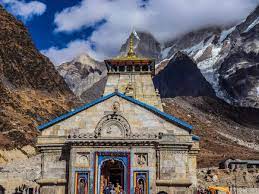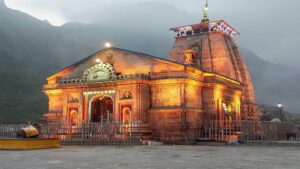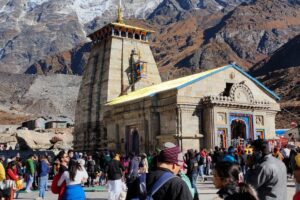Kedarnath Temple


Kedarnath is a town located in the Rudraprayag district of the Indian state of Uttarakhand. It holds great religious significance for Hindus as it is home to one of the twelve Jyotirlingas, which are sacred shrines dedicated to Lord Shiva. The town is situated in the Garhwal Himalayas at an elevation of approximately 3,583 meters (11,755 feet) above sea level.
The main attraction in Kedarnath is the Kedarnath Temple, an ancient and revered shrine dedicated to Lord Shiva. According to Hindu mythology, the temple is believed to have been built by the Pandavas (characters from the Indian epic Mahabharata) and later revived by Adi Shankaracharya in the 8th century.
Pilgrims visit Kedarnath as part of the Char Dham Yatra, a pilgrimage circuit that also includes Yamunotri, Gangotri, and Badrinath. The temple is open only for a limited period each year, generally from late April to early November, due to the extreme weather conditions in the region.

Reaching Kedarnath involves a trek of about 16 kilometers (10 miles) from Gaurikund, the last roadhead before the temple. Pilgrims can either trek or hire mules and palanquins for the journey. The region surrounding Kedarnath is known for its breathtaking landscapes, with snow-capped peaks, lush green meadows, and pristine rivers.
It’s important to note that Kedarnath gained international attention in 2013 when the region was severely affected by flash floods and landslides, causing significant damage to infrastructure and loss of life. Since then, efforts have been made to restore and rebuild the area to welcome pilgrims once again.
Kedarnath, nestled in the Garhwal Himalayas of Uttarakhand, India, is a sacred pilgrimage site and a haven for those seeking spiritual solace amidst awe-inspiring landscapes. The holiest of the Char Dham Yatra, Kedarnath is dedicated to Lord Shiva and is situated at an altitude of approximately 11,755 feet.

The Kedarnath Temple, an ancient and revered shrine, is the focal point of the town. Surrounded by snow-capped peaks and perched near the Mandakini River, the temple is a testament to the region’s spiritual significance and architectural grandeur. Pilgrims embark on a challenging journey to reach Kedarnath, often trekking through breathtaking mountain trails and experiencing the profound beauty of the Himalayas.
The trek to Kedarnath is not only a pilgrimage but also an exploration of the rugged yet mesmerizing landscapes. The scenic beauty along the way includes dense forests, alpine meadows, and the melodious sound of the Mandakini River flowing through the valley.
The spirituality of Kedarnath extends beyond the temple, encompassing the Samadhi of Adi Shankaracharya. Adi Shankaracharya, the great Hindu philosopher, is believed to have attained Mahasamadhi at Kedarnath, and his samadhi is an important pilgrimage spot for devotees.
The Kedarnath region is blessed with natural wonders such as Chorabari Tal (Gandhi

Sarovar), a glacial lake surrounded by snow-clad peaks, adding to the spiritual and visual richness of the area.
Despite being one of the most challenging pilgrimage destinations due to its high altitude and harsh climate, Kedarnath’s magnetic allure lies in its combination of profound spirituality and the breathtaking grandeur of the Himalayas. Pilgrims and nature enthusiasts alike find solace and inspiration in the sacred landscapes of Kedarnath, making it a destination that resonates with both religious and natural splendor.
Kedarnath Temple is a significant Hindu shrine dedicated to Lord Shiva, and it is located in the Garhwal Himalayan range near the Mandakini River in the state of Uttarakhand, India. Situated at an altitude of approximately 3,583 meters (11,755 feet) above sea level, the temple is one of the twelve

Jyotirlingas, which are considered to be the most sacred abodes of Lord Shiva.
Kedarnath Temple: The temple is an ancient structure believed to have been built by Adi Shankaracharya in the 8th century. It is one of the twelve Jyotirlingas, which are sacred representations of Lord Shiva. The temple is constructed in the Himalayan Kedar style of architecture and stands amidst stunning snow-capped peaks.
Pilgrimage Destination
Kedarnath is a prominent pilgrimage site for Hindus, attracting thousands of devotees each year. It is part of the Char Dham Yatra, a sacred pilgrimage circuit that includes Yamunotri, Gangotri, and Badrinath along with Kedarnath.
Ancient History
The temple has ancient origins, and its construction is credited to Adi Shankaracharya in the 8th century. However, the current structure is believed to have been built in the 7th century by the Pandavas, as per Hindu mythology.
Architecture
The temple is constructed in a traditional Himalayan style with large stone slabs and is adorned with intricate carvings. Due to the harsh weather conditions, the temple remains closed during the winter months and reopens in the spring.
Accessibility
Kedarnath is not easily accessible by road, and pilgrims have to trek through challenging mountainous terrain to reach the temple. Helicopter services are also available for those who prefer a faster mode of transportation.
Natural Beauty
Besides its religious significance, the region around Kedarnath is known for its breathtaking natural beauty. The snow-capped peaks, the Mandakini River, and the surrounding mountains add to the spiritual and serene atmosphere of the place.
Tragedy in 2013
In June 2013, the region faced a devastating natural disaster, including flash floods and landslides. The Kedarnath Temple complex suffered significant damage, but reconstruction efforts have been ongoing to restore and rebuild the site.

